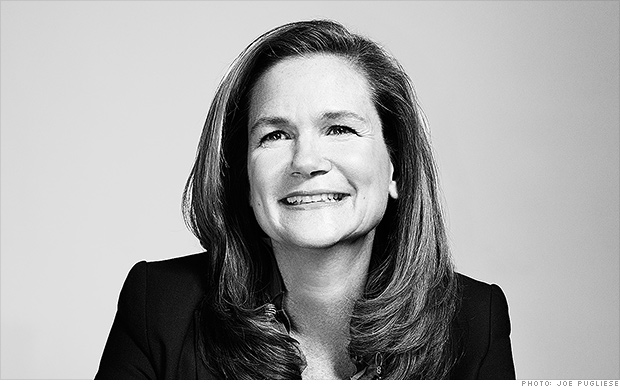
"There's a place for active and passive investments," says Amy Schioldager, head of beta strategies at BlackRock.
NEW YORK (Money Magazine)
Look at buzzwords in the world of ETFs, which are nearly all index funds. From "fundamental" to "smart beta" to "dynamic," they all point to the notion that there's a more clever way to index.
Fundamental funds have been around since 2005. Their designers say there's a flaw in standard indexes: The greater a company's total market value, the bigger place it holds in an index.
So when investors go gaga over Google (GOOG, Fortune 500) and drive up its price, an index fund must own more of it. Fundamental funds rank companies by other measures, such as sales and dividends. As a result, they lean, like Dimensional, toward value. But their creators argue that this may be more than compensation for risk. Rather, there's a chance to take advantage of behavioral biases, underweighting stocks the crowd loves too much.
"If you're contrarian, in the long run you can do better," says Jason Hsu of Research Affiliates, which built the index behind the $2.6 billion Power-Shares FTSE RAFI U.S. 1000 ETF (PRF).
The competition to create new indexes is getting stiffer. Among the entrants is BlackRock, a $4 trillion money manager that runs 7,000 different investment strategies. You may know the company better for its iShares brand of ETFs. BlackRock has since late 2011 launched 10 iShares funds offering some kind of enhanced index, and investors have poured in nearly $8 billion.
Related: Stocks, bonds? In 2014, think cash
BlackRock's biggest unit has roots (via acquisitions) in a company that in 1971 created the first indexed account for a pension fund. David Booth (LINK TK) worked on that fund. Two of BlackRock's new ETFs tilt based on the same small and value effects Dimensional goes after. But if Dimensional is akin to elegant, cultish Apple, iShares are like open-source Android. Since ETFs trade like stocks, they are available to anyone with a brokerage account, to combine in any way.
"There's a place for active and passive strategies," says Amy Schioldager, 51, BlackRock's head of beta strategies. ("Beta" is finance-speak for capturing the market's return.)
BlackRock has found particular success with iShares MSCI USA Minimum Volatility (USMV). It's built on research arguing that staid stocks, such as utilities with hefty dividends, may in the long run match or beat market returns without as much pain along the way. (A hypothetical version of the index the ETF follows would have earned 8.2% annualized over 10 years, vs. 7.2% for the S&P 500.) So-called low-volatility funds have had enormous appeal since the financial crisis.
"This is a great strategy for someone who's been a heavy bond user," says Schioldager, who adds that BlackRock launched the strategy at the request of institutional clients. At a time of measly bond yields, investors want other ways to capture income or reduce volatility.
Some market watchers think low-vol stocks may be about to run out of steam. Money has poured into the space -- not just via indexers but from active funds too -- driving up valuations. "It's always worrisome when a product becomes the darling of investors," says Morningstar analyst Samuel Lee.
Will the low-vol investors stick around when performance fades? BlackRock says the company keeps funds open even when strategies go out of style. Schioldager says it isn't necessarily BlackRock's job to take sides in philosophical debates about investment strategies. The company aims to create cheap, well-designed tools. (Minimum Volatility charges 0.15%.) "We offer building blocks," says Schioldager.
The takeaway for you. As indexish strategies proliferate and advisers push the latest, greatest ways to do better, figuring out which theories hold water could be daunting. Getting this precisely right may not matter.
Related: Couple with $1.2 million betting too big on stocks
Research Affiliates tabulated results for approaches including value tilt, a version of low volatility, holding stocks in equal proportions, and even monkeys throwing darts at the stock pages. Every one, (simulated) monkeys included, beat the market. Why? Almost any strategy other than ranking stocks by market value, as normal indexes do, tilts to small, value, or both, said RA.
The upshot: Many of these funds may lag together when blue-chip growth stocks lead, and you shouldn't pay up just because a new index sounds sophisticated. If you buy an ETF with a twist, stick to the cheaper options.
More fund managers' strategies:
David Booth, chairman and co-CEO of Dimensional Fund Advisors
Andrew Lo, professor of finance at the Massachusetts Institute of Technology ![]()
Managers can't beat the market. Monkeys can.
A test of alternative index strategies found that they all had an edge. Here's a look at annualized returns, 1964 to 2012.
| 9.7% | 11.5% | 11.2% | 11.8% | 11.6% | 11.3% |
NOTE: Monkey is average of 100 simulations, SOURCE: "The Surprising 'Alpha' from Malkiel's Monkey and Upside-Down Strategies" by Robert Arnott, Jason Hsu, Vitali Kalesnik, and Phil Tindall
First Published: January 13, 2014: 5:49 PM ET
Anda sedang membaca artikel tentang
Picking ETFs that try to beat the market
Dengan url
http://bugarasakti.blogspot.com/2014/01/picking-etfs-that-try-to-beat-market.html
Anda boleh menyebar luaskannya atau mengcopy paste-nya
Picking ETFs that try to beat the market
namun jangan lupa untuk meletakkan link
Picking ETFs that try to beat the market
sebagai sumbernya
0 komentar:
Posting Komentar